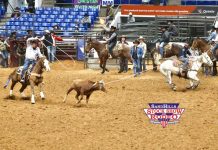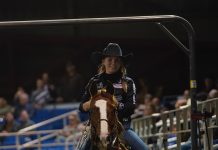Preparing for hard to catch steers
For most team ropers the hardest steer to catch is when they are high team back, have 11 seconds to win and all they have to do is catch. Watch the ropings and notice how many teams fail in that situation. It’s not as common in the higher numbers, but it does happen. The lower number roping, the more common it is. Often times little things go wrong and that’s where you have to be able to ride and control your horse and take a high percentage shot.
For example, say you back in the box and have 11 seconds to win. You’ve drawn a steer with small horns that goes to the right. In this situation I usually rope a neck most of the time. I’m comfortable with this shot because we rope mulies all the time. People ask me all the time why we rope mulies. There are so many benefits and it’s part of our preparation to win. I had this conversation the other day with a friend that didn’t believe in roping necks. He is an ex pro football player. We debated the philosophy on why we rope necks. I said, “Are you telling me in football you don’t prepare for every possible situation and then have a counter plan?” He said, “Okay, you’ve got me. No one ever made me think of it like that.” He went home and bought some mulies. If you’ve ever waved it off where you knew you had a 50/50 chance of catching, wouldn’t it be better if your percentage of roping around the neck was much higher because you were prepared for that situation?
That’s one of the reasons why all my lessons start with the high teamer scenario where you have 11 seconds to catch. Show me your run as a team. If the header reaches a coil, lets his horse move out, then gives the steers’ head back to his heeler and the heeler misses… then when we watch the video I show the header it was really his fault the heeler missed because he didn’t set the run up correctly. There’s no denying the video when it shows the steers’ head and shoulders go back up the arena after the header turns. When you have 11 seconds to win the roping you have to set the run up to give your heeler the best chance to win. That means pulling the steer at the correct angle to give your heeler the chance to catch.
This is just one scenario to prepare for. You really need to prepare for all the situations that can arise at a roping and be confident you can catch. The other day I bought some steers and tried to buy an assortment of horns. I wanted high, flat, small, some that went straight up 12 to 14 inches off the base of the head to make people pay attention to the tips. One of the worst things is when people tell me they have 12 even steers and only rope the good ones. My first question is, “Have you been to a roping where all the steers are good?” If you enter and there are over 100 head in the roping, you’re going to draw some that are not easy. Some will be fast, some will be slow. In the practice pen you need an assortment of steers and not score the one you have trouble with. That’s the cow you need to learn to catch. The practice pen is supposed to be about preparation to give yourself the best opportunity to win when you leave home to compete.
What’s new with me: Recently Pace Feed, of X Factor Team Roping, called and asked if I wanted to shoot a video with them and do some cross promotion. He wanted to do it on the Speed Trainer. I told him I wanted him to go through the steps of how I used it. In a matter of five minutes I told him what his two weaknesses were and he was shocked. He said it was amazing. He was very excited and we worked on a few things on the Speed Trainer like reaching and doing things faster. As with most higher numbered ropers, it doesn’t take them long to see the benefits of the Speed Trainer.
It really is amazing when I set it up close and do our stop watch drills. It’s almost like a golf simulator where their weaknesses are exposed. The Speed Trainer has made my lessons much more successful. I can get people to ride, swing their rope and do things correctly sitting still before trying to do it while riding their horse. Instead of just showing people what they have to do to get better, I’ve actually been able to help them improve. If you cannot do it correctly sitting still, the chance of be correct while riding your horse is remote. When higher numbered ropers see the benefits, it’s always a lot of fun and gratifying for me.



